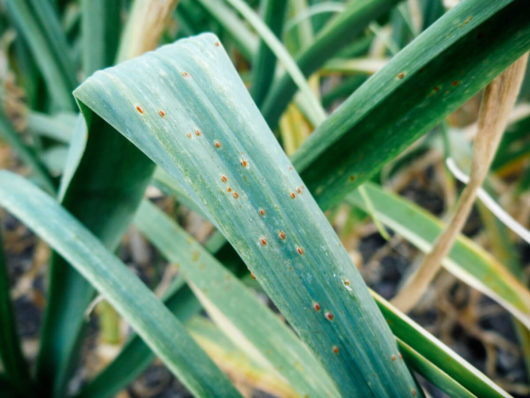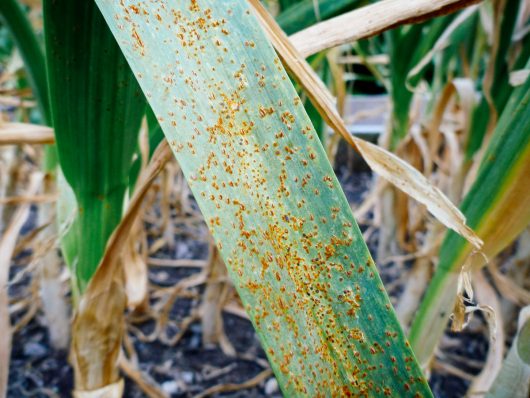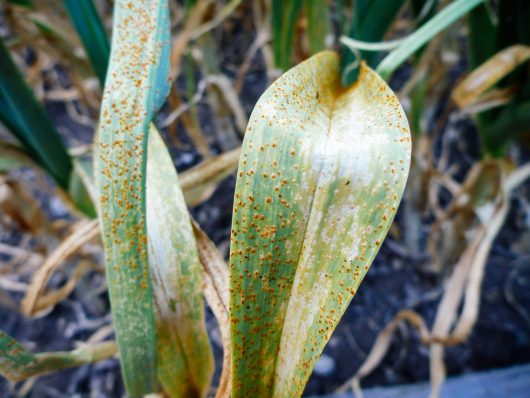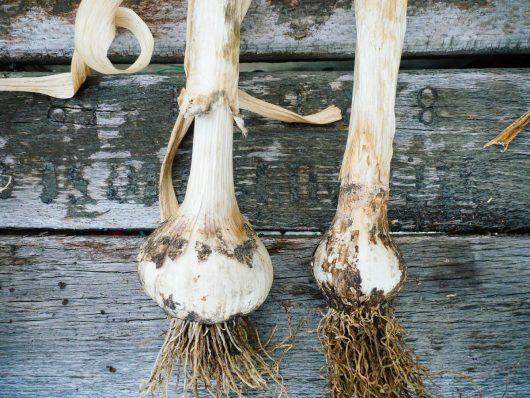
After a particularly rainy and dismal spring, followed by May Gray (the sometime predecessor of California's coastal June Gloom), a small patch of my garlic plants started developing white and yellowish-orange flecks on their leaves.
The flecks intensified, spread to neighboring garlic plants, and soon were infecting entire leaves, causing some to wilt and die off early. I even had the disease consume an entire plant, but luckily, it was close to harvest time and the garlic bulb survived.
Rust is a fungal disease that affects garlic, but can also invade other alliums such as leeks and onions. The spores of this relentless fungus (Puccinia allii) travel by wind, so a rust infection in one part of the garden may affect garlic (or other alliums) in another part.

As the fungus spreads, the flecks become orange and black pustules, indicating a common reinfection of rust in the same season.

A severe case of garlic rust, especially one that appears early in the season, can reduce bulb development or kill an entire crop outright.
Homemade remedies (with mixed results) can be found online, but in all honesty, there's not much an organic gardener can do once garlic rust sets in.
The only way to get rid of the fungus is by snipping off the leaves as soon as you see the rust start to appear. Throw the infected leaves in the trash (not the compost bin!), wash your hands and clothes, and disinfect your shears to prevent the fungus from spreading.
Even with the infected leaves removed, the garlic stalk should continue to photosynthesize and send energy down to the bulb.
Garlic affected by rust is still edible (and tasty) and unless the infection was severe, you should get a decently sized bulb at harvest time. There's no need to prematurely pull your crop unless the entire plant is brown and dead. (Like dead dead, not "ready and ripe" dead.)
True story: I had a garlic that was so badly infected that I had to cut off almost all its leaves. All that remained was a healthy green stalk and a bright green mohawk, both of which hung on for the next three weeks until harvest, and I was able to yank an average-sized bulb. Whether the bulb continued to develop after its hefty haircut, I can't be sure — but there was no harm in leaving it in the ground.
Below is a comparison of a healthy head of garlic with only a slight case of rust in the middle of spring, versus a garlic that had been heavily infected over winter. The healthy garlic is the same size or even larger than my unaffected crop, while the infected garlic is noticeably smaller.

Though the stunted garlic produced fewer and smaller cloves, they were still firm and flavorful and looked no different (other than being mini-sized and rather cute — I found them to be the perfect size to toss whole into a roast).
Onion plants infected with rust typically form smaller bulbs as well, but are otherwise safe to eat (just discard the infected leaves before curing them). The same goes for leeks, which might develop thinner stems if the crop is heavily affected by the fungus.
You are pretty much at the mercy of the weather when it comes to allium rust, but there are a few things you can do to try to prevent it:
- The fungus flourishes when the weather is cool, sunlight is low, and humidity is high. If you live in this type of climate or had a very wet/gray season, avoid watering your garlic plants late in the day, and especially avoid watering the leaves if they will not have a chance to dry out before evening.
- Grow your garlic in the sunniest spot possible, and allow enough space between plants for air to circulate among the foliage.
- Rotate your crops and do not grow garlic in the same area where rust appeared in the previous three years on any allium crop.
Even if your crop is plagued by garlic rust this season, all is not lost — you can still use the cloves as seed garlic for next season. A study conducted by the University of California found that seed garlic taken from rust-infected plants did not cause rust in the resulting new crop.
Simply choose the largest cloves from the cream o' the crop of your properly cured and stored garlic heads, and give it another go this year!
This post updated from an article that originally appeared on July 11, 2011.
The post Grrr… Garlic Rust and How to Deal appeared first on Garden Betty.
Spring is here! And to help you figure out what to do with all those weird vegetables and parts you thought you couldn't eat, The CSA Cookbook makes an excellent addition to your cooking or gardening library.
from Garden Betty https://ift.tt/2rwPZOI
No comments:
Post a Comment